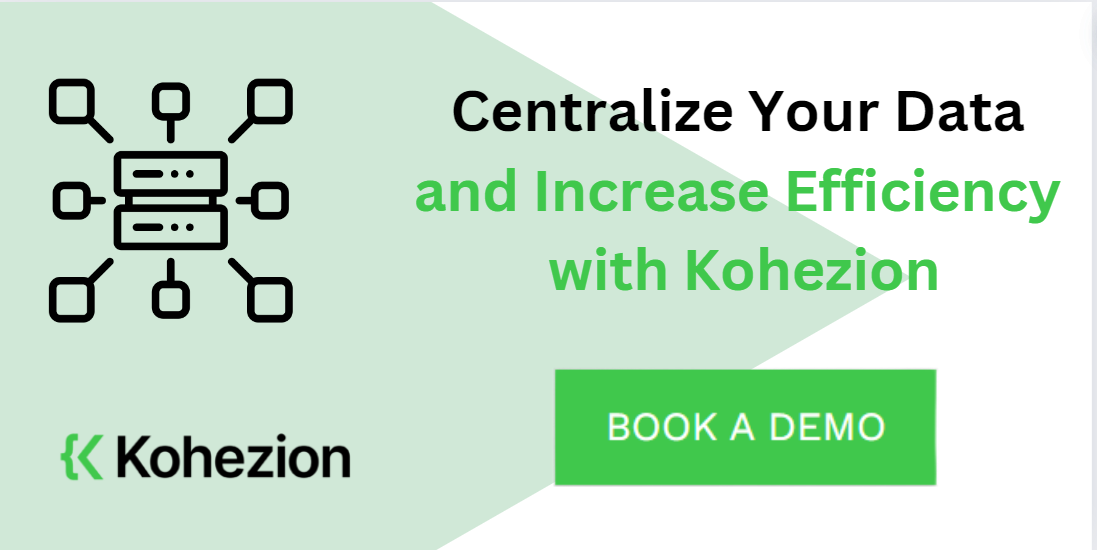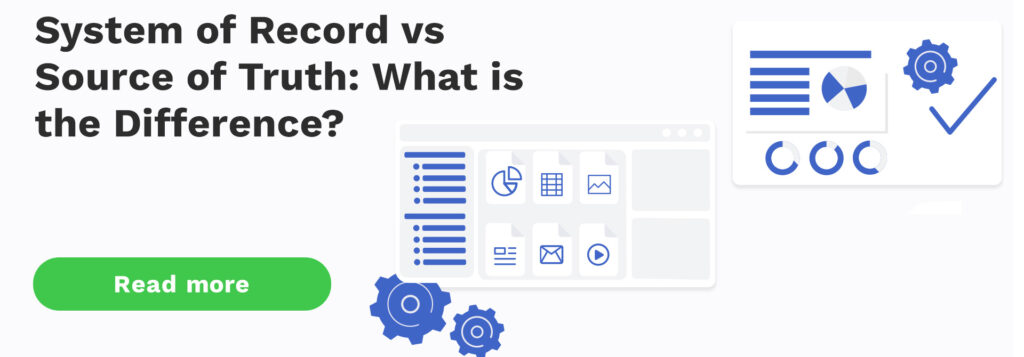Data centralization refers to the practice of collecting, storing, and managing all data in a single location instead of having it scattered across multiple platforms and vendors. This approach provides quick and easy data access, enables a 360-degree view of the business, and supports deep and holistic analysis.
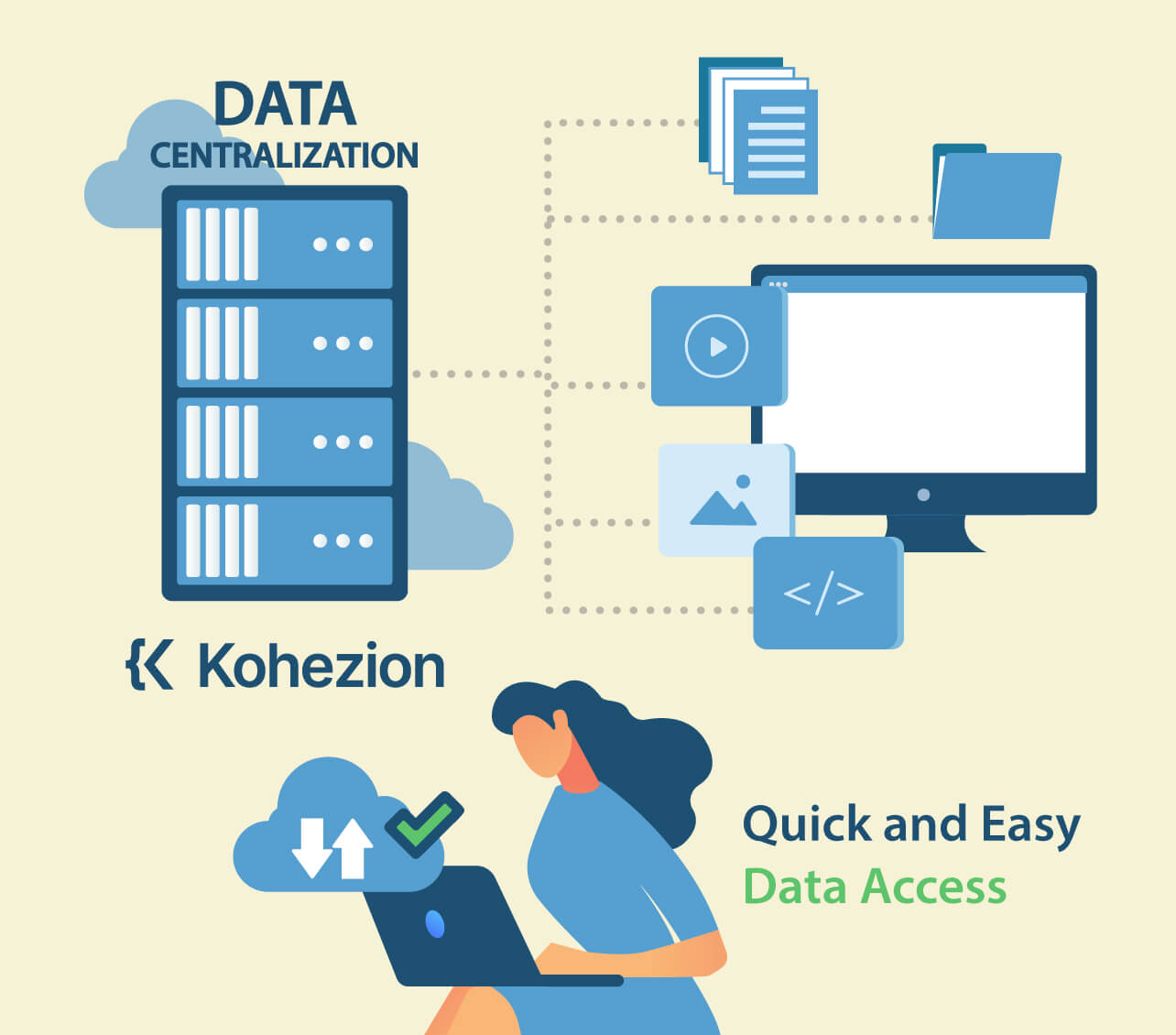
Centralizing data minimizes information silos, improves data quality, and makes it easier to see and predict the potential impact of emerging trends or proposed changes across different departments. Examples of centralized data management systems include online database software, data warehouses, and data lakes. Centralizing data helps organizations streamline processes, improve efficiency, and make better-informed decisions.
It is estimated that about 5 quintillion bytes of data are produced each day.
Centralized data: Why should you care?
1. To reduce duplication of data and improve data accessibility
Centralizing data can greatly reduce duplication and improve accessibility. When data is spread out across multiple platforms and connections, it can result in inaccurate or duplicated data, making it challenging to identify processes that lead to inefficiencies and waste.
Centralizing data allows you to improve your data governance capabilities, minimizing the risks involved in mishandling information and providing fewer opportunities for errors to arise.
2. To increase the efficiency of data processing and analysis
By centralizing data sources, each division of an organization has access to a common source of trusted data, resulting in increased productivity, optimized collaboration, and more confident decision-making.
Companies can save resources as centralized data makes inefficiencies more visible, while solutions become more evident and effective.
3. To improve data quality and accuracy
When data is scattered across multiple sources, it becomes difficult to maintain consistency and accuracy. This can lead to errors, redundancies, and inaccuracies, which can ultimately affect business decisions and operations. By centralizing data, an organization can create a single source of truth that is accessible to all departments.
4. To improve customer experience
Centralizing data can provide a 360-degree view of the customer. When all data is standardized and linked together, businesses can better understand their customers and their needs, leading to personalized experiences and increased loyalty.
For example, by centralizing customer data, businesses can track customer behavior across multiple channels and devices, allowing them to tailor their marketing efforts and messaging accordingly.
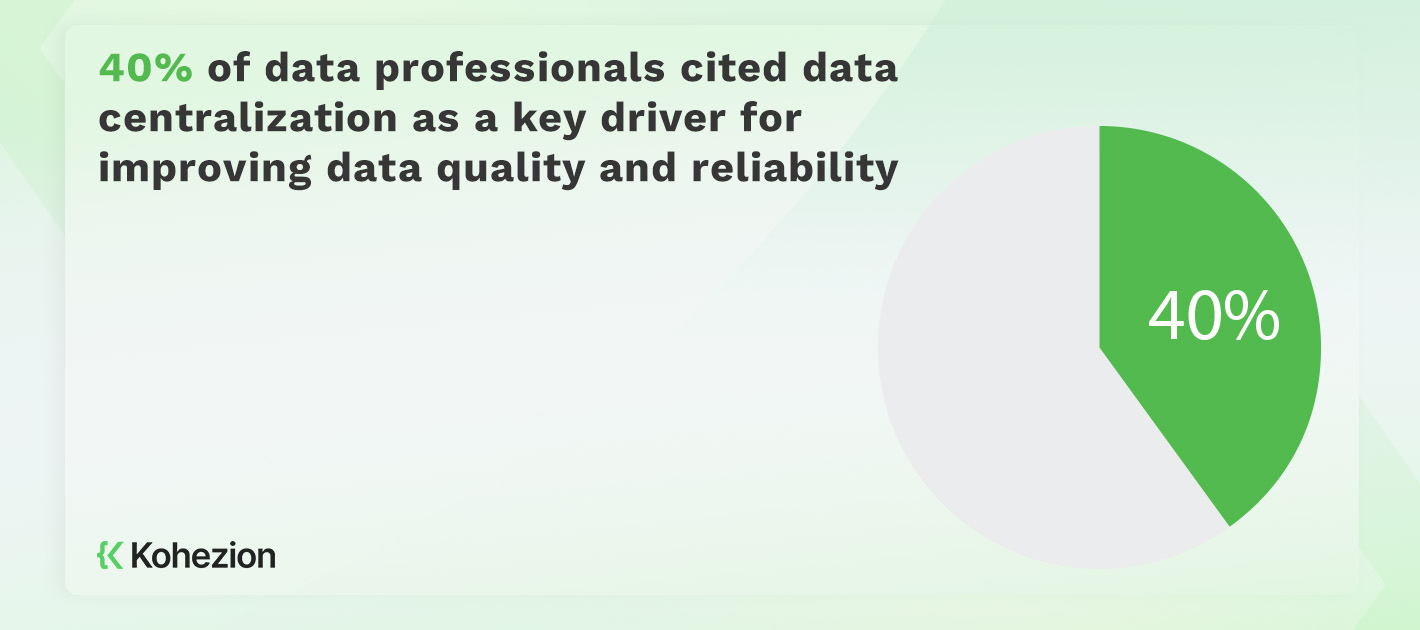
5. To increase the effectiveness of data-driven decision-making
By centralizing data, businesses can ensure that everyone is working with the same high-quality information, promoting consistency and transparency throughout the organization. This approach also enables cross-functional collaboration between product, technology, and business teams, promoting data competency and a data-driven culture.
6. To increase transparency and stakeholder awareness
Centralizing data within an organization can increase transparency and stakeholder awareness by creating a single source of truth that is accessible to everyone. This ensures that all stakeholders have access to the same data, eliminating surprises and allowing for proactive adjustments to be made to reach sales goals.
7. To improve data security
A root cause of mistrusting data is poor data quality, which can arise due to multiple users interacting with different data sources leading to inaccuracies and redundancies. A centralized solution will bring transparency to your processes, allowing everyone within an institution to access the same data, creating a single source of truth.
8. To improve agility and adaptability
Teams across the organization can access and analyze data in real time, allowing them to make data-driven decisions that can be adjusted as needed.
For example, a company might use centralized data to track customer behavior across different channels, identify trends and patterns, and adjust marketing strategies accordingly.
We'll buid your first application for you. At no extra cost.
Let us build your first business application for free. Go from an idea to an application in under 2 weeks.

How to start and implement a data centralization project?
Step 1: Decide why you are centralizing data
Before starting a data centralization project, decide why you are centralizing data.
Examples of reasons why an organization may choose to centralize its data include gaining a comprehensive view of its business, improving reporting and decision-making, breaking down data silos, and developing a data-oriented culture.
Step 2: Identify and prioritize critical data assets
First, consider the relevance of the data to your business. This means identifying data that is essential to your business operations and decision-making processes. For example, financial data, customer data, and sales data are often critical data assets for many businesses.
Next, consider the impact of the data on your business. This means identifying data that has a significant impact on your business outcomes and goals. For example, if you are a healthcare provider, patient data would be a critical data asset that has a significant impact on patient outcomes and satisfaction.
Finally, consider regulatory requirements. This means identifying data that is required by law or regulation to be collected, stored, and protected. For example, if you are a financial institution, you may be required to collect and store data related to financial transactions and customer information to comply with regulatory requirements.
Step 3: Create a data management plan with defined processes and standards
It is estimated that about 5 quintillion bytes of data are produced each day. Data management helps define processes and standards for managing and securing data, ensuring data integrity. The key components of a data management plan include defining the scope of the project, identifying data sources, establishing data quality standards, defining data access and security protocols, and developing data backup and disaster recovery plans.
Start by identifying your goals and objectives for the project. This will help determine the scope of the plan and the data that needs to be centralized. Next, identify all data sources and establish data quality standards to ensure data accuracy and consistency. Develop data access and security protocols to control who has access to the data and how it can be used.
Finally, create data backup and disaster recovery plans to ensure that data is protected in case of a security breach or system failure.
Step 4: Establish a data governance framework
Establishing a data governance framework is critical for successful data centralization projects. This framework should include policies, procedures, and standards for managing data quality, security, and compliance. Assigning roles and responsibilities to individuals within the framework is also important to ensure accountability and consistency.
The framework should enable consistent checks to monitor data quality, security, and compliance. Regular audits should be conducted to ensure compliance with legal and organizational standards. Additionally, the framework should include data monitoring, data lineage, catalogs, user permissions, and role-based access controls to manage access control and optimize role-based security.

Step 5: Implement data transformation strategies such as ETL, Data Warehousing, Data Governance, and Data Visualization
There are two main strategies to consider: ETL and ELT.
ETL, or extract, transform, and load, involves extracting raw data from various sources, transforming it according to specific metrics, and then loading the transformed data into a data warehouse. The benefit of ETL is that it allows companies to anticipate all the ways they want to slice and dice data on the front end. However, it can be limiting in a rapidly shifting market where it's impossible to fully forecast future metrics.
ELT, or extract, load, and transform, on the other hand, involves extracting and loading all of a business's raw data into storage indefinitely, without first deciding how it might be used or transformed. The data can then be transformed as businesses identify new questions or measurements. The benefit of ELT is that it gives businesses the ability to easily ask new questions about their data as their needs change. However, it can be overwhelming if not managed properly.
If you have a clear idea of the metrics you want to track and analyze, ETL may be the better approach. If you anticipate a lot of change and want to be able to easily pivot as new questions arise, ELT may be the better choice.
Using a modern business intelligence dashboard will bring your data to life for everyone in your organization with accuracy, security, and speed, creating teams that understand data, use it throughout their processes, and value a data-first culture.
Step 6: Implement additional consistency-driven approaches
To ensure data consistency across different systems in a data centralization project, implement the Aligned Data Architecture. This approach involves creating a standardized data model that is aligned with the organization's business goals and objectives. It allows for consistent data definitions and structures, ensuring that data is accurate, complete, and reliable.
Customer Experience Management (CEM) can also improve the quality of customer data by providing a holistic view of customer interactions and preferences. This can be achieved by integrating customer data from different sources and analyzing it to gain insights into customer behavior and preferences.
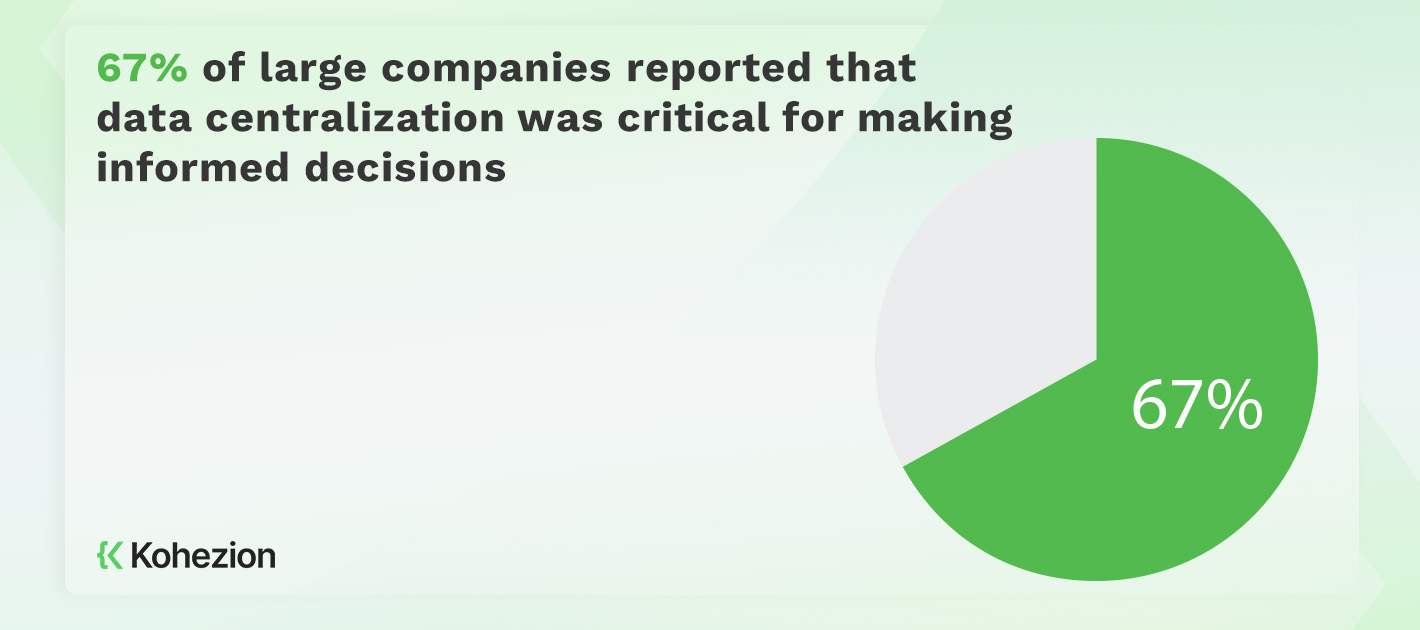
Step 7: Orchestrate data effectively through data orchestration strategies
To effectively orchestrate data through data orchestration strategies such as Business Intelligence, SharePoint, PowerPivot, or Excel Services, (or Kohezion), start by centralizing your data through a cloud-data warehouse. This central hub will enable cross-functional collaboration between product, technology, and business teams, promote data competency and data-driven culture, and allow data literacy across functions.
For example, businesses can push Google Adwords data to Salesforce to enrich Salesforce data. However, when Adwords, Salesforce, and other data sources are centralized, you will be well-placed to engage in in-depth analysis and leverage BI tools to make better data-driven decisions for the business as a whole.
Step 8: Migrate to cloud storage platforms
Research and select a cloud storage provider that meets your organization's needs in terms of cost, security, scalability, and performance.
Develop a migration plan that includes timelines, resource allocation, and risk management strategies. Ensure that your data is properly formatted and optimized for cloud storage. This includes compressing files, removing duplicates, and encrypting sensitive data.
Begin the actual migration process, monitoring progress and addressing any issues that arise. Test your data in the cloud environment before fully committing to the new storage platform. Once your data is in the cloud, optimize your storage by implementing best practices such as data tiering, data lifecycle management, and automated backups.
Some organizations may face challenges during the migration process, such as data loss, downtime, and security breaches. To mitigate these risks, it's important to have a solid backup plan, test your migration thoroughly, and involve key stakeholders in the process.
What tools can be used to centralize your company's data?
1. Big Data Warehouse
A Big Data Warehouse is a centralized repository that collects and manages large volumes of structured and unstructured data from various sources within an organization. It uses a schema-on-write architecture to ensure consistent data format, quality, and accuracy. The warehouse is organized into multiple tiers, with the top tier being a front-end client that provides analysis, data mining, and reporting tools. The middle tier has the analytics engine, while the bottom tier holds the database server.
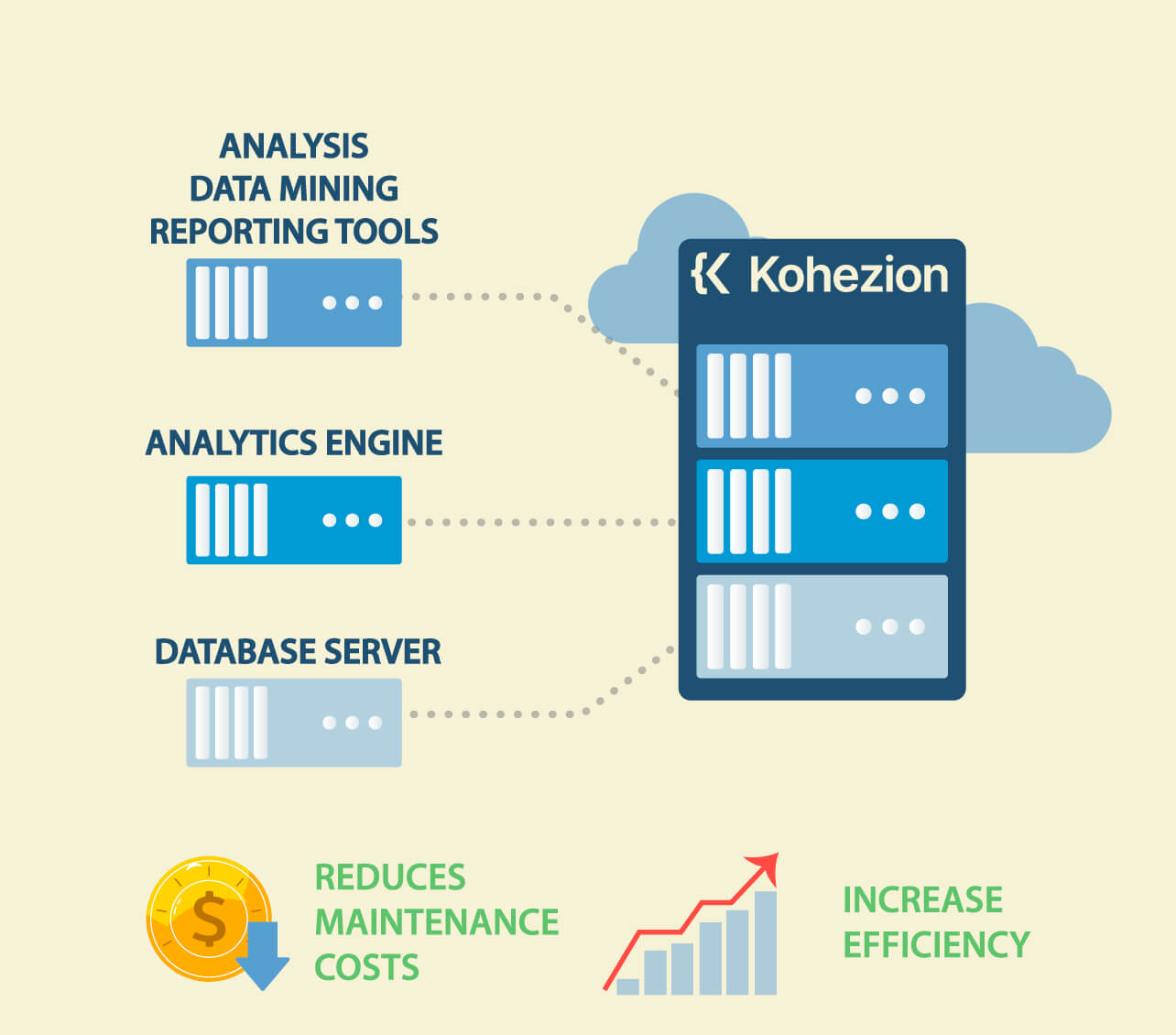
Organizations typically use cloud data warehousing platforms like Redshift, BigQuery, and Snowflake. These cloud data warehouses offer scalability, flexibility, and optimal performance for complex analytical processes. They also eliminate the need for database administrators and large teams of data engineers, which reduces maintenance costs and increases efficiency.
2. Cloud Data Lakes
Cloud data lakes are centralized repositories of raw and unprocessed data from various sources that enable organizations to store, manage, and analyze massive amounts of data. They provide a flexible and scalable way to store both structured and unstructured data in a flat architecture with a schema-on-read approach. This allows data analysts and scientists to access and analyze data in its raw form, making it easier to derive insights and create machine learning models.
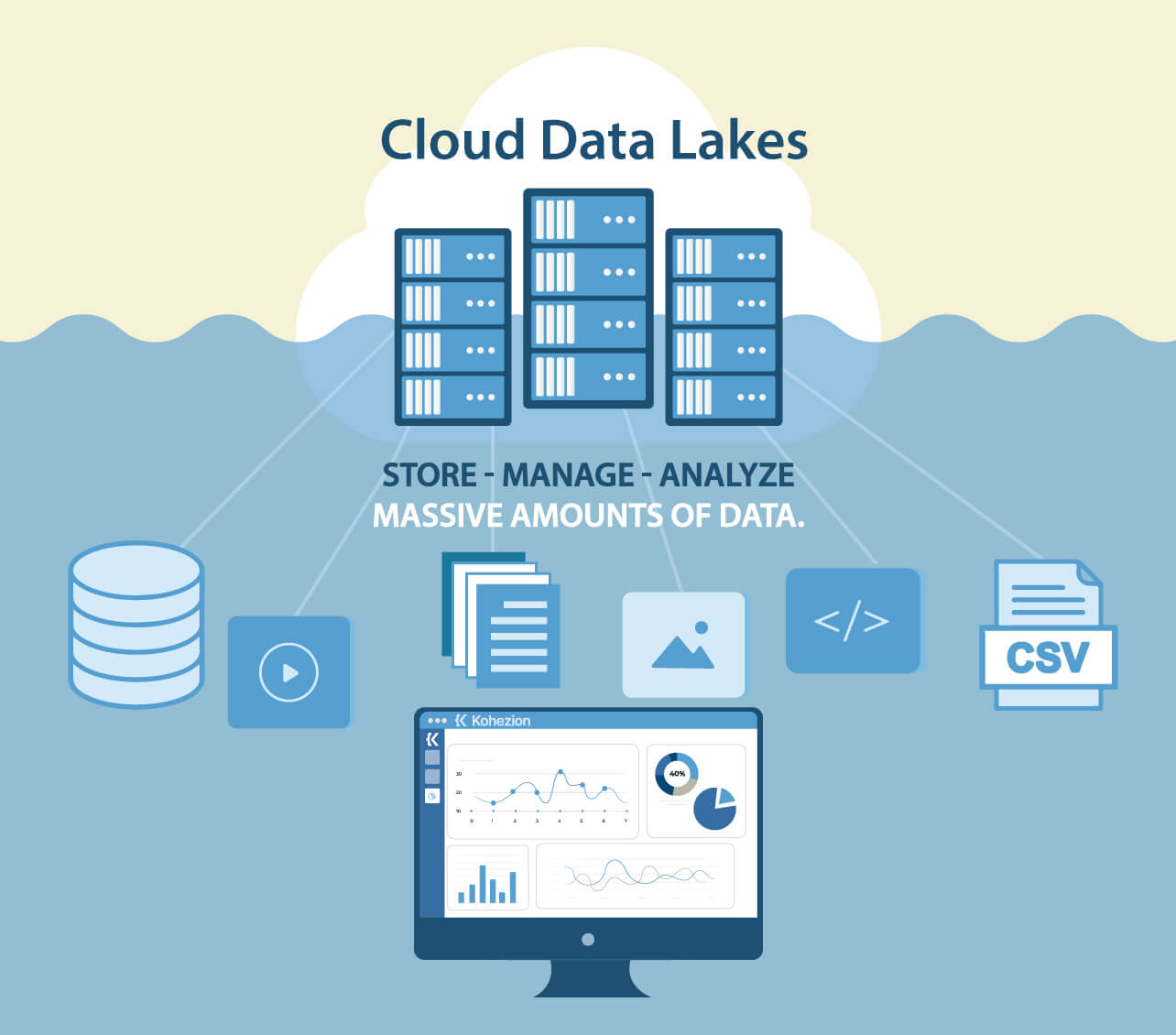
Popular cloud data lake providers include Amazon S3, Microsoft Azure Data Lake Storage, and Google Cloud Storage. They offer features such as data ingestion, cataloging, indexing, and security to help you manage your data more efficiently. For instance, Amazon S3 provides unlimited storage, near-infinite scalability, and high durability, while Azure Data Lake Storage offers hierarchical namespaces, multi-protocol access, and enterprise-grade security and compliance.
3. Database Systems
There are different types of database systems that can be used to centralize a company's data. Relational databases are the most commonly used and are based on the relational model, using tables with rows and columns to store data. NoSQL databases, on the other hand, are non-relational and use flexible data models to store different data types. Object-oriented databases store data as objects with properties and methods.
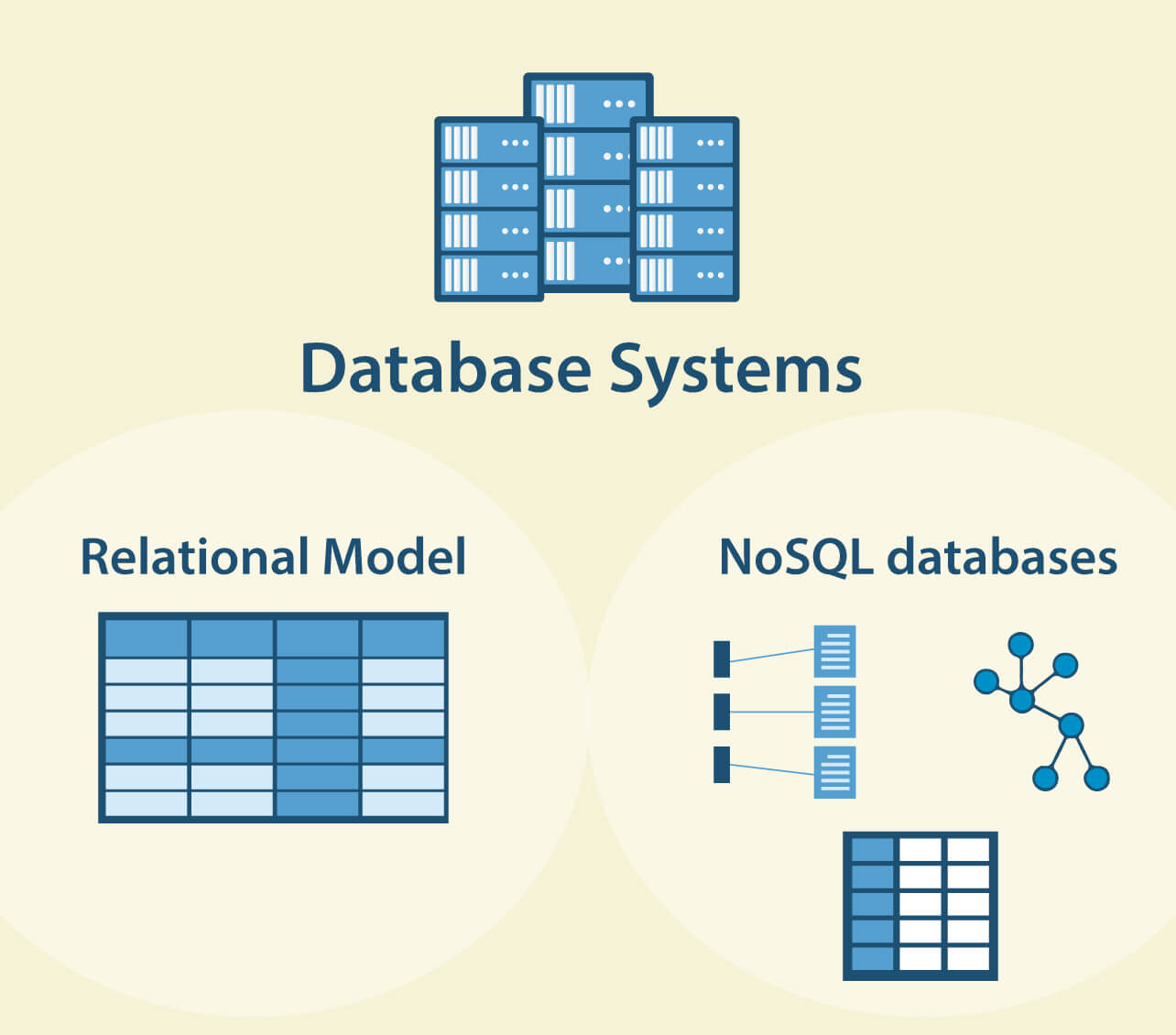
For a company looking to centralize its data, a relational database system (like Kohezion) would be the most suitable option. This is because relational databases are highly structured and allow for consistent data format, quality, and accuracy, making it easier to consolidate data from multiple sources. Relational databases have been around for a long time and have a well-established ecosystem of tools and resources, making them easier to implement and maintain.
4. Analytics Tools
Ad hoc analysis tools provide the flexibility to slice and share data with ease, while visual exploration allows business teams to work with data in a visual way without breaking the backend.
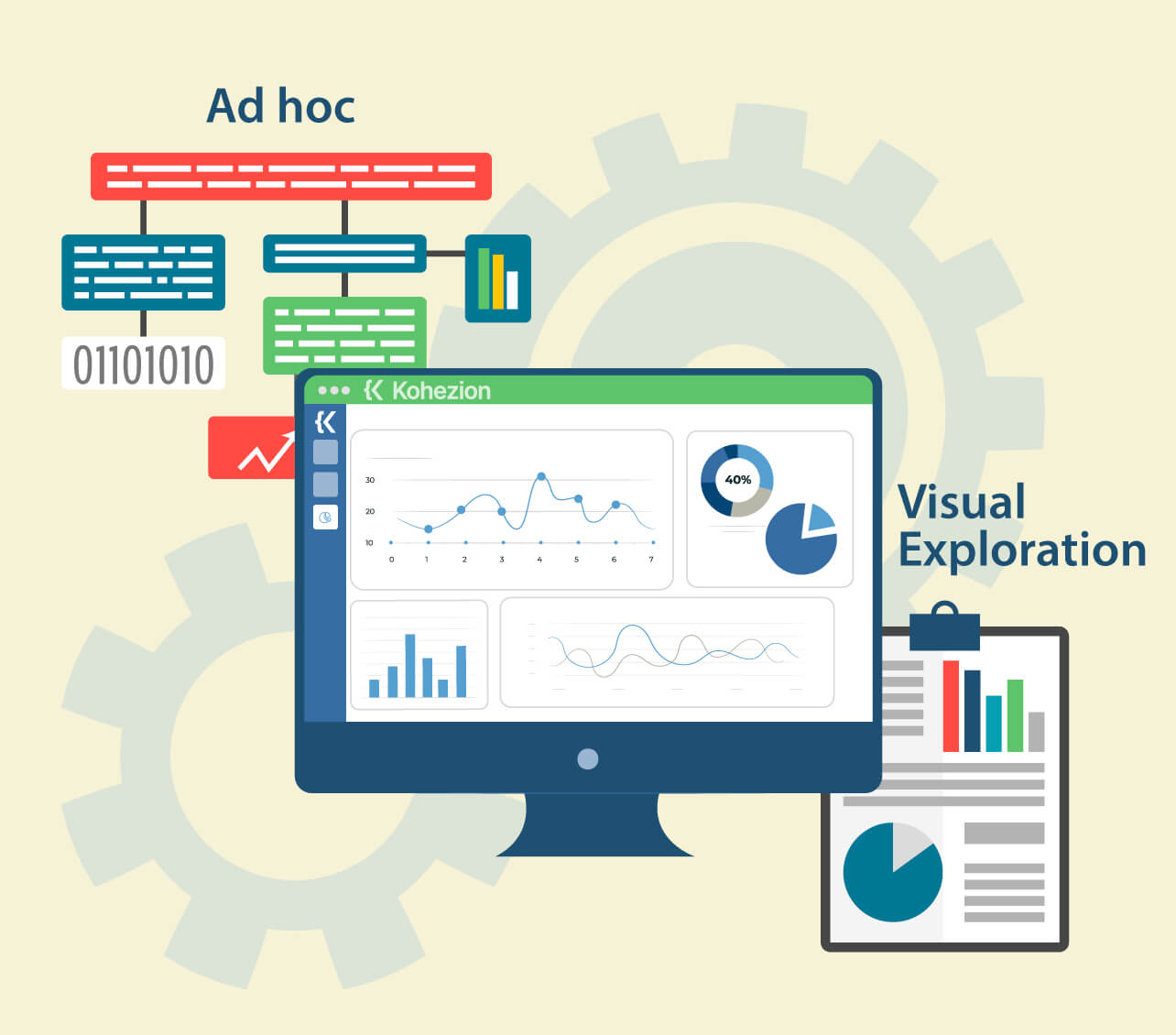
Creating verified, reusable building blocks to distribute to teams throughout the business reduces database load and repetitive requests for the same data.
Embedded analytics make presenting data a breeze. Customized styles make reports look on brand, while access to top charts and customized visualizations allow users to quickly access and analyze their data.
5. Data Collection Tools
Data collection tools can collect and organize data from various sources. Some of the data collection tools include web scraping tools, survey tools, and data entry tools.
Web scraping tools are used to extract data from websites and can be used to collect data on competitors, prices, and customer reviews.
Survey tools can be used to collect data from customers, employees, or other stakeholders and can provide valuable insights into customer satisfaction, employee engagement, and market trends.
Data entry tools are used to input data into a centralized system and can help to ensure data accuracy and consistency. Check out Jooble for example, where you can find remote data entry jobs.
Centralize your data using the Kohezion relational database system.
Kohezion is a powerful relational database software that enables users to create applications for managing non-conventional data structures that go beyond the limitations of traditional spreadsheets' rows and columns.
Here's a list of 6 features that will be useful when centralizing your data:
Online Forms
Kohezion's online forms enable you create customized forms that bring the submitted data straight into your main database, without the need to export and re-import it later for you to be able to work with it.
Online forms are used by professionals such as:
- Healthcare providers such as doctors, physiotherapists, dentists, and chiropractors
- Non-profit organizations collecting funding information from donors
- Researchers working on multiple projects
- Small and medium-sized businesses gathering customer feedback

Data Visualization Tool
With Kohezion's data visualization tool, you can proactively save time and track key performance indicators (KPIs) in real-time.
You can use:
- Pivot tables: Pivot tables are an excellent example of data visualization tools that aggregate and categorize large volumes of data, providing valuable statistical insights. Kohezion's pivot table feature is user-friendly, allowing you to easily drag and drop data points and customize visual elements. For example, you can calculate sums and averages from your data and export them to Excel. Pivot tables also facilitate secure team collaboration on projects by allowing sharing within Kohezion's dashboard.
- Charts & Graphs: Kohezion offers a diverse range of charting options to suit various needs like line, pie, column, pyramid, and many more. Once you're satisfied with your chart, you can export it to PDF or save it as an image in formats such as PNG, JPEG, or SVG.
- Calculations & Summarizations: Kohezion's data visualization tools also offer a wide range of calculations and summarizations for your data like sum, average, sample var, % of row total, and many more.

Mail Merge PDF
Mail merge PDF enables you to leverage your Kohezion data and generate PDFs based on a template. This feature is incredibly useful when you need to generate multiple PDFs, create personalized documents, or submit numerous lengthy applications using the same template.
Once you set up the PDF template, the mail merge function automatically populates it with data from your Kohezion account. You can easily send mail merge PDFs via email or electronically share them. This streamlined process saves you valuable time and resources.
Another practical application of mail merge PDF is in billing companies that need to send out hundreds of collection letters to clients on a monthly basis.
The mail merge PDF function is highly adaptable and can accommodate various types of information stored in a PDF, including both content and graphics. Here are some examples of dynamically generated mail merge PDFs:
- Life insurance claims
- Medicare applications
- Nursing home or long-term care applications
- Tax and other financial documents
- Employment contracts
Excel Migration Tool
Migrating from Excel to Kohezion is a simple process. Upload your Excel or CSV files, and customize the data architecture according to your needs. Whether you have a few spreadsheets or a large dataset, our migration process is quick and user-friendly. Even after the initial migration, Kohezion users can continue uploading or downloading new data from Excel or CSV files using our Excel Migration Tool on a daily, weekly, or monthly basis.
Kohezion's Excel import tool is designed for anyone managing data who seeks a more organized and secure alternative to Excel. It benefits:
- Businesses experiencing disorganization and lack of control with Excel
- Non-profit organizations, SMBs, and healthcare organizations
- Companies seeking a fast and easy migration process
Kohezion's Excel Migration Tool is designed to simplify your transition from Excel and enhance your data management experience.
- Create custom applications by migrating data from Excel
- Import data from Excel into existing applications on a regular basis
- Sync data in your applications using Excel files
- Import and link new records from Excel
- Export data to Excel or create custom CSV exports
- Export multiple search groups to Excel
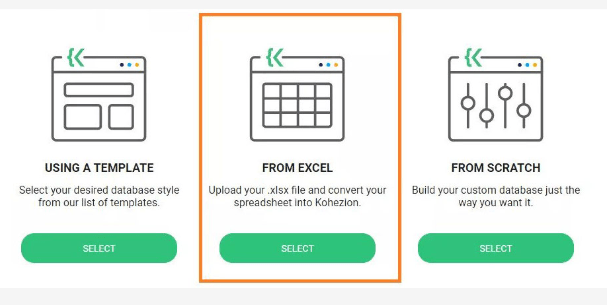
Collaboration Tool
Kohezion's collaboration tool promotes efficient idea sharing, streamlined communication, and effective teamwork, regardless of geographical location.
- Notification Center: Stay updated with two types of notifications: when a record is assigned to you or when a record undergoes changes. Additionally, you can implement custom notification events tailored to your team's needs.
- Broadcast Messages: Utilize the notification center to send broadcast messages to other users, ensuring they are informed about critical deadlines and upcoming dates.
- Chat Channels: Create dedicated channels within the platform for teammates working on the same project, enabling seamless collaboration. This feature is particularly valuable when handling sensitive data projects.
- Reminders: Set reminders and assign them to team members, guaranteeing important dates and tasks are never overlooked.
Kohezion's collaboration tool empowers teams to communicate effortlessly, with features designed for seamless project management:
- Manage entire projects and communicate directly within Kohezion
- Conduct searches directly from the notification center for easy access to vital information
- Create chat channels specific to projects and define user groups for focused collaboration
- Make changes or updates to records directly from the notification center
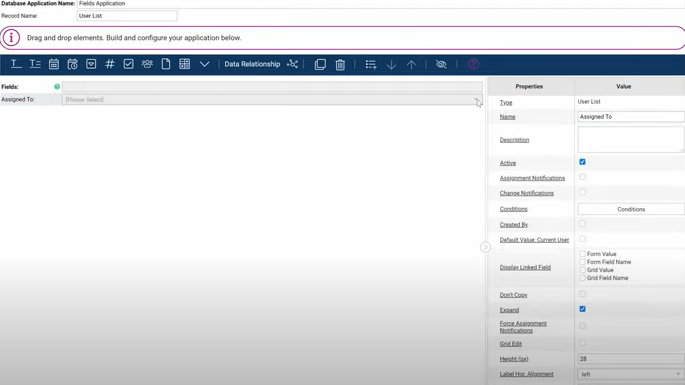
Online Dashboard
Kohezion's online dashboard offers a user-friendly and effective way to visually summarize and share your data. Create both shared and private dashboards, composed of customizable widgets that provide meaningful insights. With Kohezion, you can create an unlimited number of dashboards to suit your needs.
- Private Dashboard Keep your progress and goal tracking private by creating a personal dashboard. This allows you to monitor individual progress and track goal completion.
- Shared Dashboard Invite others to view your dashboard and collaborate effectively. Share dashboards with supervisors to review key performance indicators (KPIs) or provide teammates with at-a-glance progress reports.
You can also leverage a variety of widgets to build and customize your dashboard:
- Search Widget: Display records returned by a search, including saved searches like pivot tables. Visualize search results in tabular or graphical formats.
- Pie/Bar Charts: Create pie charts or bar charts based on application data. Select the field to chart and customize the search criteria to meet your specific needs.
- Reminders: View follow-up reminders assigned to you by teammates or supervisors, helping you stay on top of important tasks.
- Project Change Widget: Track records created or modified within a specific timeframe by users, allowing you to stay updated on project progress.
Various industries and roles can benefit from online dashboards:
- Academic Researchers: Monitor KPIs, track goal completion, and perform comparative project analysis.
- Sales Teams: Measure team performance at the end of the quarter and compare results with previous periods.
- Non-profit Organizations: Share dashboards with funders to provide a visual overview of resource allocation.
- Government: Build department-specific dashboards to present key data to lawmakers and top officials for decision-making.
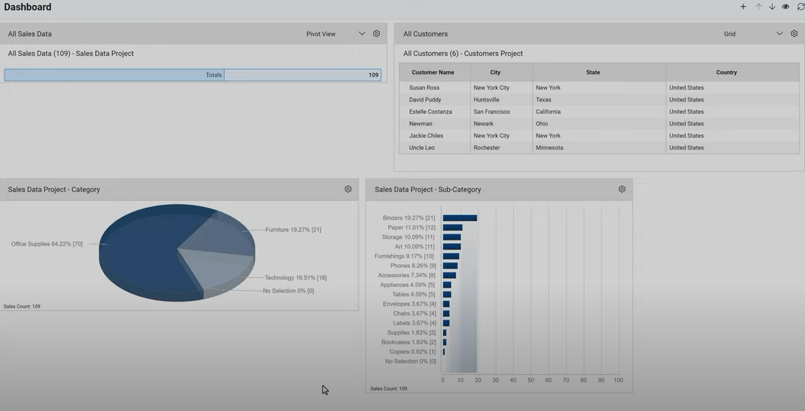
Check out more about what Kohezion can do for your organization:
Start building with a free account
Frequently Asked Questions
Benefits of centralizing data in an organization include reducing costs by eliminating bad data, increasing data culture and trust, improving speed-to-insight with simplified reporting and cross-functional insights, and building collective intelligence. Centralizing data eliminates data silos, increases collaboration, and improves data governance capabilities.
Data centralization is critical for businesses that rely on multiple data sources. There are various strategies that you can adopt to centralize their data. One approach is to use a modern data platform like Y42, which can ingest all data sources into a single UI, promoting a data-oriented culture, increasing operational efficiency, and ultimately driving business growth.
Another strategy is to use a cloud-data warehouse, such as Redshift, as the central location to collect all incoming data. This enables you to seamlessly transpose, transform, and manage data to cater to a variety of analysis requirements.
However, there are pros and cons to each approach. A modern data platform may offer more integrations and real-time monitoring, but it may also come with a higher cost. On the other hand, using a cloud-data warehouse may be more cost-effective, but it may require more technical expertise to set up and manage.
To determine the best strategy, you should consider factors such as the size of the organization, the type of data being collected, and the goals of the centralization effort.
Employees within an organization can access centralized data in a variety of ways. One way is through a centralized data platform, which can provide access to files, employee data, payroll processes, and login history in one place. Another way is through a common source of trusted data, which allows each division of the organization to access the same data.
It is important to ensure data security by implementing access permissions, which restrict access to sensitive data only to authorized personnel. Overall, centralized data supports automated tasks, data reusability, data sharing, and a more productive workflow without disruption.
Centralizing data can be a challenging task for organizations, but the benefits of doing so are numerous. One of the main challenges is the difficulty of securing and integrating company data from decentralized sources. Without a centralized system, data silos, discrepancies, and security issues can arise, making it difficult for organizations to derive accurate insights and make informed decisions.
Additionally, managing data and ensuring data consistency can be difficult, as well as gaining access to or socializing data. However, centralizing data allows you to improve your data governance capabilities, minimize risks involved in mishandling information, and provide fewer opportunities for errors to arise. Centralization also enables better cross-functional shareability and collaboration, ensuring that everyone is on the same page regarding metrics, data logic, naming conventions, and calculations.
When centralizing data in an organization, taking measures to ensure data quality and security is critical. The first step is to create a centralized single data source across the organization to mitigate the negative impacts of poor data quality. Data governance and supervision play a crucial role in providing accountability, managing access control, and optimizing role-based security. The enterprise data centralization strategy should be equipped with robust data to reduce the risk of improper access, data tampering, and leakage of sensitive information.
Additionally, having a strict control framework in place will check and monitor the data quality for inconsistencies. It is important to measure the performance of the data strategy and define proper matrices to understand the efficiency of the data management processes and procedures.
When centralizing data, you must take steps to ensure data governance and collaboration. One important step is to create a data-oriented culture by breaking down silos and promoting cross-functional collaboration between product, technology, and business teams. This can be achieved by building scalable disciplinary teams with diverse skill sets and experience to promote data competency. Additionally, creating a centralized hub or dashboard will enable teams to access data, share intuitive analytic tools, and generate insightful reports.
To ensure data governance, it is important to decide how data will be managed and governed. You should ask questions such as how data will be collected and stored, what practices will help govern data quality and accessibility, and what kind of data team structure will be put in place.
To take full advantage of centralized data, it's important to invest in a data warehouse or data lake and integrate all your data sources. This will reduce reporting times, make inefficiencies more visible, and save resources.
Consider leveraging BI tools to perform in-depth analysis and make better data-driven decisions for the business as a whole. Best practices include automating processes, creating data dumps to share with other systems, and using tools to better manage and track budgets and expenses.
Data centralization is the practice of collecting, storing, and maintaining data in a single location. This approach helps reduce the complexity of managing data, ensures data consistency, and enables more efficient collaboration.
Decentralization of data is a practice where data is distributed across different organizational departments without the need for a central repository. This approach helps reduce the risks involved in mishandling information, provides less opportunity for errors to arise, and allows teams to work independently.
In summary, the centralization of data helps ensure data consistency, promotes collaboration, and provides a 360-degree view of the business, product, and customers. Decentralization of data, on the other hand, reduces the complexity of managing data, allows teams to work independently, and minimizes the risks involved in handling information.
A centralized database is a system where all information is collected and stored in one location but can be accessed from multiple points. An example of this is an HR management system where employee data, payroll processes, and login history are all stored in one place for easy access and organization.
